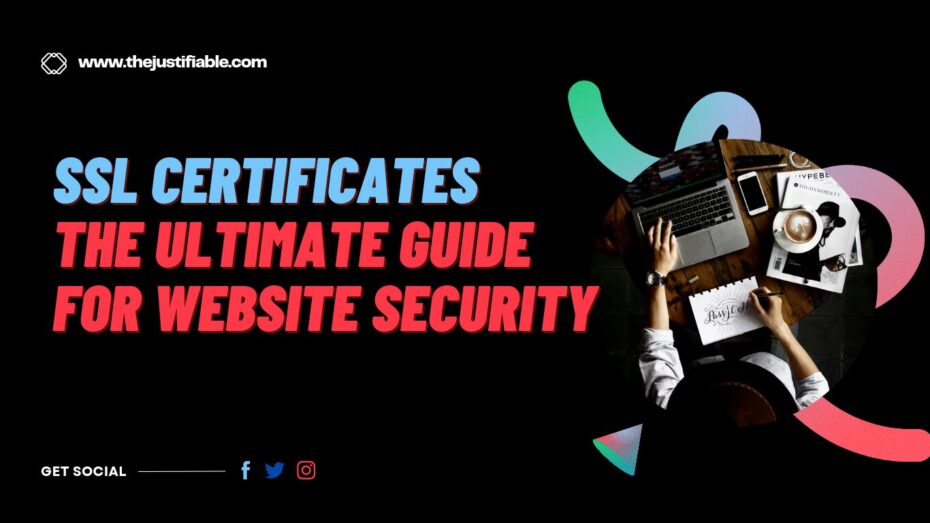Table of Contents
In the age of cyber threats and digital advancements, understanding the essence and purpose of SSL certificates becomes paramount. As we increasingly share our personal, financial, and sensitive data online, the security of this information is of utmost importance. This is where SSL certificates come into play.
What are SSL Certificates?
SSL certificates, or Secure Socket Layer certificates, act as a digital passport for websites. They provide a secure and encrypted pathway between a user’s browser and the server hosting the website. At a basic level, think of an SSL certificate as a lock on your door, but in the digital realm, it’s safeguarding the information exchange between your website and its visitors.
An SSL certificate contains crucial details about the owner of the certificate, including the owner’s email address, certificate usage, duration, and a unique certificate identification, among others.
When a browser connects to a secured website, it retrieves the site’s SSL certificate to verify its authenticity. If trusted, the browser establishes an encrypted connection, indicated typically by the ‘https’ in the URL and a padlock icon in the address bar.
Why Every Website Needs SSL Certificates for Security
In today’s digital landscape, every website, regardless of its content or function, should prioritize the security of its users. Here’s why SSL certificates are non-negotiable for every site:
- Data Encryption: With an SSL certificate, the data transmitted between the server and the user’s browser is encrypted. This means that even if hackers intercept the data, they cannot read or use it due to the complex encryption algorithms in place.
- Authentication and Trust: When visitors see the ‘https’ and the padlock icon in your website’s address, it instills a sense of trust. They can be assured that they’re communicating with the legitimate server and not a malicious actor. This is especially vital for e-commerce websites or any platform where users might input personal or financial information.
- Improved SEO Rankings: Beyond security, search engines like Google give preference to SSL-certified websites, making them rank higher in search results. This is a nod to the importance Google places on user safety and ensures that secure sites get more visibility.
- Protection from Phishing Attacks: Phishing websites often try to impersonate legitimate sites to steal user data. Having an SSL certificate helps in assuring users that they are on the genuine website and not a malicious clone.
The Technical Workings of SSL Certificates
In the vast digital ocean, SSL certificates act as lifebuoys, ensuring that data doesn’t drown in the potential whirlpool of cyber threats. But to genuinely appreciate the protection offered by these certificates, one must delve into the intricacies of their technical workings.
It’s a world where encryption is the hero, and the play between public and private keys forms the plot.
Encryption Basics: Public and Private Keys
At the heart of SSL certificates lie two critical components: the public key and the private key. Imagine sending a locked box to someone. The public key is like the lock itself, available to anyone and everyone. It can be used to lock (or encrypt) the data. However, only the private key—held securely by the intended recipient—can unlock (or decrypt) that box.
When someone wants to send secure information to a website, they use the website’s public key (provided by the SSL certificate) to encrypt the data. Once encrypted, the data can only be decrypted using the associated private key, ensuring that only the intended recipient (the website owner) can access the content.
The SSL Handshake Process
The SSL handshake is an elegant dance of authentication. It’s a behind-the-scenes process that most website visitors won’t even notice, but its impact is profound. The handshake establishes a secure connection, setting the stage for all subsequent encrypted data transfers.
When a browser attempts to access an SSL-secured website, it requests the website’s SSL certificate. This certificate, issued by a trusted third party known as the Certificate Authority (CA), vouches for the website’s authenticity. Once the browser verifies the certificate, it sends a signal to the server, indicating it’s safe to establish a secure connection.
The two parties then exchange encryption keys, and just like that, a secure tunnel, immune to external eavesdropping, is created. This entire interaction is the crux of the SSL handshake process.
Symmetric vs. Asymmetric Encryption: How SSL Combines Both
The realm of encryption is marked by two dominant players: symmetric and asymmetric encryption. Asymmetric encryption, as previously discussed, involves the duo of public and private keys. It’s highly secure, but it’s also resource-intensive, making it less suitable for large data volumes.
Enter symmetric encryption—a system where a single key is used for both encryption and decryption. It’s faster and more efficient for larger data sets, but the challenge lies in securely sharing the key between the communicating parties.
SSL ingeniously marries the strengths of both systems. Initially, the asymmetric encryption process kicks in, with the browser and server using public and private keys to share a unique symmetric key. Once both parties have this symmetric key, they switch to the more efficient symmetric encryption for the rest of their communication.
In weaving together the best of both encryption worlds, SSL certificates offer robust, efficient, and impenetrable security, ensuring that our online data exchanges remain confidential and untampered.
Benefits of Using SSL Certificates
In the sprawling digital landscape, SSL certificates stand as silent sentinels, guarding the gates of information exchange. Their presence might be inconspicuous, but their role is undeniably vital.
The advantages of integrating SSL certificates into a website go far beyond the obvious realm of data encryption. Let’s delve deeper into the manifold benefits these security stalwarts offer.
Protecting User Data and Enhancing Website Security
In an age where data is the new gold, ensuring its safety is paramount. SSL certificates shine in this domain, enveloping users’ sensitive information in a cloak of encryption. Be it financial details, personal identification, or even casual interactions, SSL ensures that these data packets are transmitted securely from the browser to the server.
With the exponential rise in cyber threats, an unprotected website becomes an easy prey for hackers. Here, SSL certificates act as a formidable barrier, preventing data breaches, thwarting eavesdropping attempts, and ensuring that the sanctity of user data remains inviolable.
SSL Certificates and SEO: How it Affects Rankings
In the realm of website performance, Search Engine Optimization (SEO) is akin to a magic potion, and SSL certificates play a pivotal role in this alchemy. Search engines, with Google at the forefront, are continuously tweaking their algorithms to prioritize user experience and safety.
Recognizing the crucial role SSL certificates play in web security, search engines reward SSL-embedded websites with better search rankings. It’s a win-win: websites get better visibility and higher traffic, while users are assured of a secure browsing experience.
In essence, the marriage of SSL certificates and SEO is not just about enhancing website security; it’s about amplifying its digital footprint in the most authentic way.
Building Trust with Your Visitors
Beyond the digital algorithms and technical jargons, the web is, at its core, a place of human interactions. Trust, therefore, becomes the bedrock of online exchanges. SSL certificates contribute immensely to this trust-building exercise.
The subtle shift from ‘http’ to ‘https’ in a website’s URL, complemented by the reassuring padlock icon, sends a powerful message to visitors: they’re in a safe space.
For e-commerce platforms or service-based websites, where transactions are routine, this assurance translates into better user engagement and increased conversions. A visitor is more likely to interact, transact, and engage with a website they deem trustworthy.
In the digital ecosystem, where skepticism is rampant, SSL certificates serve as badges of credibility, fostering an environment of trust and reliability.
Different Types of SSL Certificates
In the intricate web of online security, SSL certificates emerge as a beacon of protection. But like any effective tool, they aren’t one-size-fits-all. Depending on the nature of a website, its goals, and its audience, there are different types of SSL certificates tailored to meet specific needs.
Venturing into this realm, it becomes evident that understanding these variations is key to harnessing the true potential of SSL for optimal website security.
Domain Validation (DV) SSL Certificates
Domain Validation, commonly referred to as DV SSL, is the entry-level certificate. It’s akin to a basic security check, ensuring that the domain’s ownership is validated and legitimate. The certification authority primarily confirms that the domain name registrant has control over the domain. The process is relatively swift, often requiring just a simple email or DNS record verification.
Due to its straightforward nature, DV SSL certificates are typically more affordable and are an ideal fit for blogs or personal websites where financial or personal data transactions aren’t the primary focus. However, because it only validates domain ownership and not the legitimacy of the actual organization, it might not be the best fit for websites where building trust is imperative.
Organization Validation (OV) and Extended Validation (EV) SSL Certificates
Stepping up the ladder of validation and trust, we encounter the Organization Validation (OV) and Extended Validation (EV) SSL certificates. These aren’t just about verifying domain ownership; they delve deeper, ensuring that the organization behind the domain is legitimate and credible.
For an OV SSL certificate, the issuing authority performs a thorough check, which includes validating the organization’s existence, its operational status, and physical location. Visitors can view these organizational details by checking the certificate information, instilling a greater degree of trust.
The EV SSL certificate takes this even further. It’s the gold standard of SSL certificates, demanding rigorous checks by the issuing authority. Beyond the OV checks, EV requires further documentation to validate the organization’s identity.
Websites with EV SSL display a noticeable green bar or padlock in the address bar, a clear sign of top-tier security and authenticity. For e-commerce sites, large corporations, or any platform handling sensitive user data, EV SSL is often the recommended choice.
Wildcard vs. Multi-Domain SSL: Choosing What’s Right for You
In the expansive world of domains and subdomains, Wildcard and Multi-Domain SSL certificates play distinct yet crucial roles.
Wildcard SSL certificates are designed for websites with multiple subdomains. Imagine having a primary website domain like ‘example.com’ and various subdomains like ‘blog.example.com’ or ‘shop.example.com’. A Wildcard SSL certificate secures the main domain and an unlimited number of its subdomains. It’s like having a security umbrella that extends its protection to every nook and corner of your digital domain realm.
On the other hand, Multi-Domain SSL certificates cater to those who own multiple domain names. This type of SSL certificate is like a multi-pass, ensuring that you can secure multiple completely different domain names with a single certificate. It’s especially useful for businesses that operate across different brand names or platforms.
When deciding between Wildcard and Multi-Domain SSL, the choice boils down to the website’s structure. For those managing multiple subdomains under a primary domain, Wildcard is the way to go. But for varied and distinct domain names, Multi-Domain SSL offers the most comprehensive solution.
Common Myths Surrounding SSL Certificates
The world of SSL certificates, much like other technological domains, isn’t immune to myths and misconceptions. These notions, often rooted in partial truths or outdated information, can inadvertently deter website owners from maximizing their online security.
As with any myth, the key to debunking lies in discerning fact from fiction. Let’s embark on a journey to demystify some common beliefs surrounding SSL certificates.
SSL certificates are too expensive
In the golden age of digital evolution, viewing SSL certificates through the lens of cost can be misleading. Yes, certain premium SSL certificates come with a heftier price tag, especially those that offer Extended Validation. However, the SSL certificate landscape is diverse, with options catering to varied budgets.
Domain Validation SSL certificates, for instance, offer basic protection at affordable rates, making them accessible to individual bloggers and small website owners.
Furthermore, the narrative surrounding the expense should be reframed to consider the potential cost of not having an SSL certificate. Data breaches, loss of customer trust, and potential legal ramifications can weigh heavily on a business, both financially and reputationally.
When perceived as an investment in building trust and protecting user data, the costs associated with SSL certificates become a justified expense in the broader scheme of online business operations.
Only e-commerce websites need SSL certificates
This myth is akin to saying only vaults containing diamonds need security. While e-commerce sites undoubtedly handle a significant volume of sensitive transactions, they aren’t the sole entities requiring protection.
Any website that processes user information, be it as simple as a login form or a newsletter subscription, stands at risk. Cyber threats don’t discriminate based on the nature of data; they exploit vulnerabilities.
Furthermore, SSL certificates aren’t solely about encryption. They also provide authentication, ensuring that users are communicating with the intended website and not a malicious imposter. In today’s digital realm, where phishing attacks are rampant, even informational or portfolio websites can benefit from the trustworthiness and authenticity that SSL certificates confer.
Installing SSL certificates will slow down my website
In the fast-paced world of the internet, where every millisecond counts, this myth has gained traction, often deterring website owners from adopting SSL. While it’s true that encryption requires processing power, the impact on website speed is minimal and often imperceptible to users. Modern servers are equipped to handle SSL operations efficiently, ensuring swift and smooth data encryption.
Moreover, advancements in SSL protocols have paved the way for features like session resumption, which reduces the time taken for SSL handshakes, thus speeding up secure connections. Also, with the advent of HTTP/2, a major revision of the HTTP network protocol, encrypted websites can now even outpace their non-encrypted counterparts in certain scenarios.
In essence, the slight overhead introduced by SSL is a negligible price to pay for the robust security and trust it brings to the table. Website optimization in other areas, such as image compression or caching, can easily counteract any minor delays introduced by SSL, ensuring that users enjoy a fast and secure browsing experience.
Procuring and Installing SSL Certificates
Navigating the labyrinth of the digital universe, SSL certificates emerge as silent sentinels, shielding websites and their visitors from lurking dangers. Yet, while their importance is universally acknowledged, the path to procuring and installing them remains shrouded in mystery for many.
This journey, from choosing the right certificate to seamlessly integrating it into a website, is pivotal to achieving the emblematic ‘https’ and the coveted padlock icon. Let’s embark on this voyage, demystifying each step of the SSL certificate procurement and installation process.
How to Obtain an SSL Certificate: Vendors and Choices
The first step in your SSL journey is selecting and procuring the certificate that aligns best with your website’s needs. The digital marketplace is brimming with vendors, each offering a suite of SSL certificates tailored to various requirements.
Reputable Certificate Authorities (CAs) such as Let’s Encrypt, DigiCert, and GlobalSign have etched their names in the annals of SSL history. They’re not just vendors; they’re partners in your website’s security endeavor. Your choice hinges on several factors: the nature of your website, the level of validation you seek, and, of course, your budget.
Whether you lean towards a basic Domain Validation certificate or the more comprehensive Extended Validation option, ensure your chosen CA is recognized and trusted by major browsers and devices.
Step-by-Step Guide to Installing SSL Certificates
Once you’ve procured your SSL certificate, the installation process begins. Though this might sound daunting, with a bit of preparation and clarity, it’s a straightforward task.
- Certificate Signing Request (CSR) Generation: Before you can install your SSL certificate, you need a CSR. This is a block of encrypted text that contains details like your domain name and company information. This request can usually be generated through your web hosting control panel.
- Certificate Activation: Post CSR generation, you’ll need to submit this to your CA. They’ll use this to create your SSL certificate tailored to your domain.
- Certificate Installation: Once your CA validates your CSR and sends your SSL certificate, you’re ready for installation. The process varies depending on your web server and hosting platform. Generally, it involves accessing your control panel, navigating to the SSL/TLS section, and uploading your certificate. Don’t forget to also upload the private key, which was generated alongside your CSR.
- Verification: After installation, it’s essential to verify the certificate’s functionality. Tools like the SSL Server Test by Qualys can help you confirm that your SSL certificate is correctly installed and working as intended.
Troubleshooting Common SSL Certificate Issues
Like any digital endeavor, the SSL journey might occasionally hit a bump. Some common issues include:
- SSL Connection Errors: Often seen as ‘Your connection is not private’ or ‘This site’s security certificate is not trusted’, these can arise from expired certificates, server misconfigurations, or issues with intermediate certificates.
- Mixed Content Warnings: These pop up when a site with an SSL certificate tries to load resources (like images or scripts) over an insecure HTTP connection. Ensure all elements on your site are loaded over HTTPS to resolve this.
- Certificate Name Mismatch: This occurs if the domain name on the certificate doesn’t match the domain it’s installed on. Double-check your certificate to ensure it’s issued for the correct domain or subdomain.
- Browser Trust Issues: If your CA isn’t recognized by some browsers, visitors might get a warning. Always choose a reputable and widely recognized CA to avoid this.
Future of SSL Certificates and Web Security
The digital realm, with its pulsating ebb and flow, has always been in a state of flux. Just as businesses, content creators, and users adapt and evolve, so do the mechanisms that ensure the integrity and security of this vast cyberspace.
SSL certificates, once the gold standard of online security, now find themselves at the cusp of change, beckoning us to peer into the horizon of what lies ahead. This chapter unfolds the potential future trajectory of SSL certificates, their successors, and the broader landscape of web security.
Evolution of SSL and its Successor, TLS
SSL certificates have been the unsung heroes of the internet, tirelessly encrypting data and ensuring authenticated connections. Born in the 1990s, the Secure Sockets Layer (SSL) has since undergone several versions, each refining and enhancing its capabilities.
However, as technology sprinted ahead, vulnerabilities crept into SSL, necessitating the birth of its successor: Transport Layer Security (TLS).
The transition from SSL to TLS wasn’t just a name change; it was a significant leap forward. TLS, especially in its later versions, introduced a suite of cryptographic improvements, ensuring more robust encryption, faster handshakes, and better overall security.
As we gaze into the future, the natural progression might see SSL being fully phased out, with TLS not just being the successor but the new norm. And who’s to say TLS will be the endpoint? In the rapidly advancing world of cryptography, new protocols might emerge, setting even higher benchmarks for web security.
Emerging Threats and the Importance of Staying Updated
The future isn’t just about advancements; it’s also about challenges. As SSL and TLS protocols evolve, so do the nefarious forces seeking to exploit digital vulnerabilities. Quantum computing, a futuristic concept slowly inching towards reality, poses significant threats to current cryptographic algorithms. The power of quantum computers could potentially crack encryption methods that were once deemed unbreakable.
In this ever-escalating game of cat and mouse, staying updated isn’t a luxury; it’s a necessity. SSL and TLS certificates have expiry dates for a reason. They compel website owners to revisit, review, and renew, ensuring they’re equipped with the latest in cryptographic technology. As threats morph and multiply, regular updates, patches, and staying informed will become the cornerstone of web security.
Continuous Security: Beyond Just SSL Certificates
While SSL and TLS certificates are instrumental in securing data in transit, the future beckons a holistic approach to web security. Continuous security doesn’t stop at the encrypted padlock icon on browsers. It encompasses a multi-layered defense strategy.
End-to-end encryption, stringent authentication processes, regular penetration testing, and embracing a security-first mindset are the way forward. Web application firewalls, advanced threat detection systems, and proactive monitoring will play pivotal roles in this new age of security. In essence, while SSL and its successors lay the foundation, the pillars of future web security will be built on comprehensive, continuous, and adaptive protection measures.
Conclusion
In the grand tapestry of the digital universe, where information zips across global highways in mere nanoseconds, ensuring the sanctity and security of that data is paramount. As we’ve journeyed through the intricate world of SSL certificates and web security, it becomes evident that their role is not merely significant but absolutely crucial.
As we draw this exploration to a close, let’s underline the cardinal truths we’ve gleaned about SSL certificates and their enduring importance in the evolving web ecosystem.
Emphasizing the Non-Negotiable Nature of SSL Certificates in Today’s Web Ecosystem
In an era where digital trust is both fragile and paramount, SSL certificates stand as the bulwarks of assurance. Their presence on a website signals not just encryption but a commitment—a promise that the guardians of the website value the privacy and security of every visitor who steps into their digital abode.
Today, it isn’t just about protecting data, but about building trust. Every time a user sees the emblematic padlock icon, it engenders confidence, signaling that their data is cradled in a cocoon of encryption, safe from prying eyes.
Hence, to even contemplate a modern web ecosystem without SSL certificates is akin to envisioning a fortress without its walls. Such a fortress might still stand, but its vulnerabilities would be glaringly evident, making it a tempting target for invaders.
Similarly, in the web’s vast expanse, SSL certificates are no longer just an option; they are an uncompromising necessity.
Encouraging Regular Audits and Updates for Website Security
Like any bastion of security, the effectiveness of SSL certificates isn’t static; it’s dynamic. They are not mere tools to be installed and forgotten, but instruments that need periodic tuning. And this isn’t just true for SSL certificates, but for the entirety of a website’s security architecture.
Regular audits, assessments, and updates ensure that the security mechanisms remain robust, adaptive, and ahead of emerging threats. Just as a ship’s captain regularly checks for breaches in the hull to ensure the vessel remains seaworthy, so must website administrators remain vigilant, ensuring that the sanctum of their digital space remains inviolable.
To be lax in these regular checks is to risk obsolescence and vulnerability. And in a world where cyber threats are both sophisticated and relentless, such laxity isn’t just careless; it’s perilous. Therefore, it becomes an imperative, not just to adopt SSL certificates but to foster a culture of continuous security assessment and enhancement.







